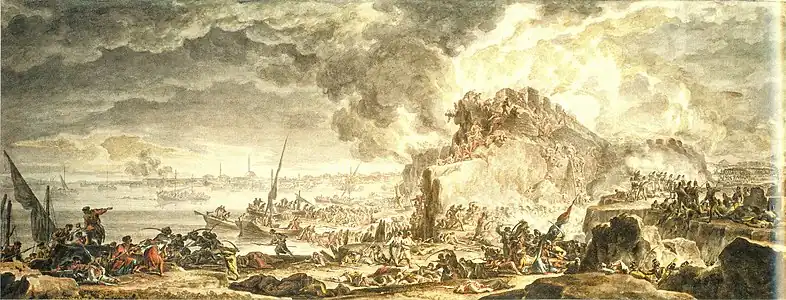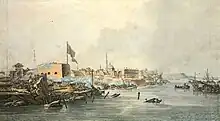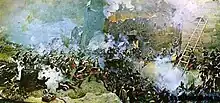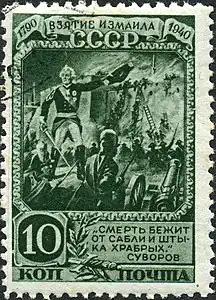Siege of Izmail
The siege of Izmail or Ismail / Ishmael / İzmail (Turkish: İzmail Kuşatması), also called the storming of Izmail[4] (Russian: Штурм Измаила), was a military investment fought in 1790 on the Black Sea during the Russo-Turkish War (1787–1792). The Russians were led by Alexander Suvorov, who had defeated the Ottomans at Kinburn, Focsani, and Rymnik, as well as participating in the siege of Ochakov. The Black Sea flotilla was commanded by the Spanish admiral José de Ribas (Iosif Deribas).
| Storming of Izmail | |||||||
|---|---|---|---|---|---|---|---|
| Part of Russo-Turkish War (1787–1792) | |||||||
 The capture of Izmail by Russian troops under the command of General-in-Chief A. V. Suvorov on 11 December 1791, Mikhail Ivanov | |||||||
| |||||||
| Belligerents | |||||||
| Commanders and leaders | |||||||
|
|
| ||||||
| Strength | |||||||
|
28,000–32,000[lower-alpha 2] 500[3] to 600[7] guns |
40,000–42,000[lower-alpha 3] 265 guns[6][3] | ||||||
| Casualties and losses | |||||||
| 4,582 to 10,000 killed & wounded[lower-alpha 4] |
23,000 to 26,000+ killed,[lower-alpha 5] including 60 pashas[6] up to 400 standards[6] | ||||||
Background
The siege of Izmail in 1790 was undertaken by order of the commander-in-chief of the Russian Southern Army, General-Feldmarshal Grigory Potyomkin. Neither Nikolay Repnin (1789), nor Ivan Gudovich, nor Pavel Potyomkin (March, 1790) were able to meet the challenge, after which Grigory Potyomkin assigned the task to Alexander Suvorov.[7]
Preparations
Trainings
Arriving at Ismail on December 13, Suvorov immediately began preparations for an assault. His troops were positioned in a semicircle 2 km. from the fortress; their flanks rested on the river, where Deribas' flotilla and the detachment on Çatal Island started the blockade. Reconnaissance was underway for several days in a row, with the participation of both Suvorov himself and his superiors; ladders and fascines were being prepared at the same time. In order to inspire the Turks with the idea that the Russian meant to conduct a proper siege, on the night of December 18, on both flanks were laid batteries, each with 10 guns: two — on the west side, 300 m. from the fortification, and two — on the east side, not more than 370 m. from the hedge. To train troops for make an assault, a moat was dug in the distance and poured ramparts like Izmail; secretly on the night of December 19 and 20 Suvorov personally showed the troops escalade techniques and taught them to act with a bayonet, with the fascines represented by the Turks.[7][3] On December 18, 2 o'clock in the afternoon, Suvorov sent a note to the commandant of Izmail:[7]
To Serasker, elders and all your society: I arrived here with the troops. Twenty-four hours to think about surrender and twenty-four hours of liberty; my first shots mean that liberty is gone; the assault is death. This is what I leave you for consideration.
The next day came a reply from serasker, who asked permission to send two men to the Grand Vizier for a command and offered to conclude an armistice for 10 days. By 20 December Suvorov replied that he could not agree to the serasker's request and gave a deadline until the morning of the 21st day. In the appointed time there was no reply and the fate of Izmail was decided.[7]
Short bombardment
The Russians had only 40 field guns, but not siege guns at all. Field artillery had no more than one set of ammunition; there was an extreme shortage of food, which could not be replenished due to winter conditions and lack of time; there were many sick soldiers.[1] Alexander Suvorov's aim was to squeeze the fortress into pincers from four sides. The Ottomans would greatly disperse their forces and would not be able to support each other in the event of a possible breakthrough of any of the sections. This applies not only to the Ottoman soldiers, but also to their guns, many of which would also go to defend against the Deribas flotilla, rather than against Suvorov's main assault columns.
One day before the assault (December 21), Alexander ordered to bombard Izmail (with naval and ground cannons),[3] a stronghold built under the direction of German and French engineers, in the region of Budjak (now in Ukraine).[7][2] The only unprotected section of the fortress was on the Danube side,[3] which was supposed to be defended by ships. Yet the Ottoman fleet had already been defeated by the Russian one during the Battle of Tendra by the great Russia's admiral of those times — Fyodor Ushakov.
An artillery duel took place. At sunrise the preparation for the assault was begun by fire from the flank batteries, Çatal, and flotilla ships; cannons were smashing Izmail until late at night; the Turkish artillery answered, but soon the firing from the fortress became weaker and finally stopped. Thanks to the fleet, the Russians had an advantage in guns.[7] The firefight started unsuccessfully for the Russians, since the lucky Ottoman cannonball hit the powder chamber of the frigate Konstantin, after which it took off into the air, but this did not help the Ottomans win the duel either. The bombardment continued until 3:00 am, but since there were no siege guns on land, the walls could not be breached.
The assault and its planning
Numbers
On the early dusky morning of 22 December 1790, the Russians hoped to take their enemy by surprise,[3] however, information about Suvorov's plans of assault was leaked to the Turkish camp. The Russians began the assault on Izmail, which had a garrison of 35,000 soldiers[6] (or 40,000[2]), of which around 15,000 regular troops and ~20,000 militias,[9] under the leadership of Aydoslu Mehmed Pasha, a firm, resolute, and battle-tested commander.[7] Suvorov had 31,000 troops, of which 15,000 were irregular and poorly armed.[6]

Plan of attack
Suvorov's troops consisted of: the right wing, commanded by Pavel Potyomkin, formed out of the columns of Lvov, Lacy, and Meknob; the left wing, commanded by Alexander Samoylov, formed out of the columns of Orlov, Platov, and Golenishchev-Kutuzov (Kutuzov); the fleet — Iosif Deribas — his landing columns under the command of Arsenyev, Chepiha, and Markov.[3] The detachment of Deribas (9,000) was to attack from the river side, with the right column of Major General Arsenyev (3 battalions and 2,000 Cossacks) was given the task to attack the New Fortress, the middle column of Brigadier Chepiha (3 battalions and 1,000 Cossacks) — the center of the coastal front, the left column of Major General Markov (5 battalions and 1,000 Cossacks) — the Old Fortress. The flotilla was ordered to approach Izmail, being built in two lines: the 1st — 145 light ships and Cossack boats with landing troops, the 2nd — 58 large ships, which by fire of heavy guns were to cover the landing. The detachment of Lieutenant General Potyomkin (7,500) was to lead the assault against the western side of the fortress with the right column of Major General Lvov to seize the redoubt of Tabia and then spread to the left, the middle column of Major General Lacy to seize the curtain wall at the Bros gate and spread to the left all the way to the Khota gate, the left column of Major General Meknob was to seize the curtain wall at the Khota gate and spread to the left. Each column consisted of 5 battalions; 150 jaegers were to go at the head, followed by 50 workers with tools, then 3 battalions with fascines and ladders, and a reserve of 2 battalions at the tail. The detachment of Lieutenant General Samoylov (12,000) was to go against the eastern front, with the leading column of Brigadier Orlov (2,000 Cossacks) was to seize the rampart east of the Bender gate and spread to the left to support the middle column of Brigadier Platov (5,000 Cossacks), which was to climb the rampart through the valley that divided the Old and New Fortress, and then contribute to the Deribas troops; 150 selected Cossacks with rifles were to march in front of each column, followed by 50 workers, and then the remaining Cossacks on foot; two battalions of infantry were to serve as a reserve for both columns, given under the command of Major General Bezborodko; left column of Major General Golenishchev-Kutuzov (5 battalions and 1,000 Cossacks) was to seize the rampart at Cilic gate and spread to the right and left. Westphalen's cavalry (2,500) was assigned to the reserve; 10 squadrons were divided into 3 detachments, which stood against the Bros, Khota and Bender gates; 4 Cossack regiments were positioned further to the east and 1 squadron was left at wagon fort.[7]

To the walls
At 3 a.m. on the 22th the 1st signal flare went up, by which the troops moved to the positions; at 5:30 a.m. by the 3rd flare the troops moved to the assault. Turks opened fire with cannons. Lacy's column was the first to climb the rampart. Lvov's column failed to take Tabia redoubt; Lacy was wounded and Colonel Zolotukhin took command and managed to take Bros and Khota gates and joined Lacy's column. Meknob's column had the hardest time, attacking the large bastion in the northwestern corner of the fortress and the one next to it to the east and the curtain wall between them instead of the curtain wall assigned to it by the disposition; here the rampart had a small height, and the serasker himself defended this section with elite Janissaries; but, despite the enormous losses, the troops of the column, under Colonel Khvostov, who replaced the wounded Meknob, brilliantly accomplished the task. Against Brigadier Orlov's column, as it began to climb the rampart, the Turks made a desperate sortie from the Bender gate. Thanks to the moved Suvorov's reinforcements (1 battalion of infantry, 7 squadrons and 1 regiment of Cossacks), the sortie was repulsed, but Orlov managed to capture the wall only with the help of Platov's troops. Platov, advancing along the ravine, met an obstacle — a curtain wall, which, crossing the stream flowing through the ravine, formed a dam, waist-deep; Cossacks crossed in the ford and, with the help of infantry battalion sent to their aid, seized the curtain wall; after that part of Platov's troops moved to support Orlov's column, while another part got in contact with Arsenyev's column. Golenishchev-Kutuzov's column after a fierce battle seized the Cilic gate. Deribas' detachment about 7 am, despite the resistance of 10,000 Turks and Crimean Tatars, successfully made the landing and seized the points assigned to him by disposition.[7]
Inside the stronghold
By 8 a.m. the Russian troops firmly established themselves on the ramparts of Izmail; the Bros, Khota, and Bender gates were opened, and the cavalry reserves entered the fortress.[7][2] The first to step on the fortress walls was Major Nekludov;[6] and after a short rest, the assault columns from different sides moved toward the center of the city. A new fierce fighting began; the Turks resisted stubbornly; every building, every scrap of land in the fortress had to be taken with the fight.[7] The Russians made their way into the Old and the New Fortresses, as well as the Citadel.[3] Garrisoned Crimean Tatars and some Turks, commanded by Qaplan Geray (cousin of the last Crimean Khan), then made a desperate attempt to recapture Izmail with 3,000-4,000 men in the Old Fortress. They overturned the Black Sea Cossacks, taking away two of their guns, but the regular infantry stopped this onslaught.[12] 5 of Qaplan's sons were killed with Qaplan Geray in person,[12] and including Maqsud Geray, descendant of Genghis Khan himself. By about 4 o'clock in the afternoon the battle subsided; Izmail was taken by the Russians.[7]
Result
Many ships, munitions and various riches (gold, silver, pearls and precious stones) went to the victors. Several thousand women, children, Jews, Armenians and Moldavians settled in the city. Of the entire garrison only one man escaped.[13] In total, the Ottoman forces had more than 26,000 casualties with the almost whole armed force of the stronghold being killed.[2] Those who were wounded were captured. Russian forces suffered only 4,330 casualties, out of which 1,815 were killed.[2] The participants of the Ochakov storming considered it a "toy" compared to the Izmail assault, and Suvorov himself later said that
"such an extraordinary storm could be dared only once in a lifetime." [14]
Mikhail Golenishchev-Kutuzov was appointed commandant of the fortress[12] for his courage in battle. And Catherine II awarded Suvorov the rank of lieutenant colonel of the Preobrazhensky Life Guards Regiment, where she herself was a colonel.[15]
The conquest of Izmail was of great political importance, as it influenced the further course of the war and the conclusion of peace in 1791.[16]
The impression made by the storming of Izmail on Turkey and Europe was numbing. The Sistova conferences were interrupted (representatives of the European powers negotiated with the Ottoman Empire[17]); the Turks began to flee from Maçin and Babadag; in Bucharest they simply did not believe what had happened, and in Brailov, despite the 12-thousand garrison, "the inhabitants asked the pasha to surrender when the Russian (troops) approached the fortress, so that they would not suffer the same fate as Izmail". In Constantinople the Ottomans remembered the legend that a blond people would come from the north and drive them into Asia. Therefore, fear and despondency prevailed in the Turkish capital, every minute expected outrage; it was strictly forbidden to talk about the actions of the Russians; when the rumor of the capture of Izmail did spread, the excitement of the people reached extreme proportions. The Ottomans spoke of the necessity of strengthening the capital, of a general militia, but the summoning of troops was not successful.[16]
Legacy
To the victory was dedicated the anthem "Grom pobedy, razdavaysya!" (Let the thunder of victory sound!) which was an unofficial Russian national anthem in the late 18th and early 19th centuries. Today it is commemorated as a Day of Military Honour in Russia. Along with the Battle of Rymnik, the Storming of Praga, and the Battle of the Trebbia, the Storming of Izmail is one of Suvorov's fabulous military achievements.
The siege is dramatized in cantos 7 and 8 of Lord Byron's verse-novel Don Juan (1823). His principal source, he states in the preface, was Gabriel de Castelnau's account of the siege in Essai sur l’histoire ancienne et moderne de la Nouvelle Russie (1820).
The monument to Alexander Suvorov in Izmail's city centre was placed in temporary storage on 12 November 2022, until city deputies decide where it will be kept permanently.[18]
Notes
- Excluding bombardment on the 21st N.S. (10 December O.S.)
References
- Petrushevsky, Alexander (1884). Generalissimo Prince Suvorov (in Russian). Vol. 1 (1st ed.). St. Petersburg: Типография М. М. Стасюлевича. pp. 383–384.
- Duffy C. Russia's Military Way to the West: Origins and Nature of Russian Military Power 1700–1800. Routledge & Kegan Paul Books Ltd. 1985. p. 188
- Kolganov 2016.
- Bodart 1908, p. 267.
- Orlov 1890, p. 52.
- Arsenyev & Petrushevsky 1894, pp. 849–851.
- Velichko et al. 1912, pp. 572–577.
- Grant 2017, p. 478.
- Valery Pоsternak. Ismail Gechidi. – Kharkiv, 2015. – p. 146.
- Orlov 1890, p. 81.
- Orlov 1890, p. 80.
- Petrushevsky, Alexander (1884). Generalissimo Prince Suvorov (in Russian). Vol. 1 (1st ed.). St. Petersburg: Типография М. М. Стасюлевича. pp. 393–394.
- Orlov 1890, pp. 80–81.
- Orlov 1890, p. 82.
- Petrushevsky, Alexander (1884). Generalissimo Prince Suvorov (in Russian). Vol. 1 (1st ed.). St. Petersburg: Типография М. М. Стасюлевича. p. 403.
- Orlov 1890, pp. 83–84.
- Orlov 1890, p. 20 (note 7).
- "The monument to Suvorov from the center of Ishmael will be removed". Ukrayinska Pravda (in Ukrainian). 12 November 2022. Retrieved 12 November 2022.
Sources
- Grant, R. G. (2017). 1001 Battles That Changed the Course of History. Chartwell Books. ISBN 978-0-7858-3553-0.
- Bodart, Gaston (1908). Militär-historisches Kriegs-Lexikon (1618–1905) (in German). Vienna and Leipzig: C. W. Stern. Retrieved 29 June 2023.
- Orlov, Nikolay Aleksandrovich (1890). Штурм Измаила Суворовым в 1790 году [The storming of Izmail by Suvorov in 1790] (in Russian). St. Petersburg: Типография Тренке и Фюсно. ISBN 978-5-4460-0232-0. Retrieved 12 July 2023.
- Arsenyev, Konstantin; Petrushevsky, Fyodor (1894). Brockhaus and Efron Encyclopedic Dictionary (in Russian). Vol. XIIа: "Земпер — Имидокислоты". Friedrich A. Brockhaus (Leipzig), Ilya A. Efron (St. Petersburg). Retrieved 2 June 2023.
- Velichko, Konstantin; Novitsky, Vasily; Schwarz, Alexey; Apushkin, Vladimir; Schulz, Gustav (1912). Sytin Military Encyclopedia (in Russian). Vol. X: "Елисавета Петровна – Инициатива". Moscow: Типография Т-ва И. Д. Сытина. Retrieved 2 June 2023.
- Kolganov, A. M. (2016). "ИЗМАИЛА ШТУРМ 1790". Great Russian Encyclopedia. Electronic version. Retrieved 8 May 2023.
